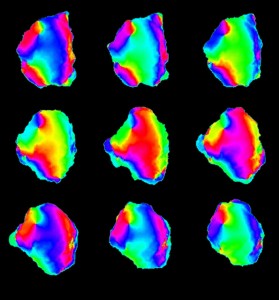Geometry of amoeboid morphodynamics Excitable waves and phase singularities of actin and lipid signaling

Amoeboid cells range from free living amoebae that migrate through the soil to capture food, to our immune cells that fight off invading bacteria. The highly deformable nature of amoeboid cells supports a wide range of biological functions such as engulfing external particles and cells, cell migration, wound healing and cancer metastasis.

© Satoshi Sawai. Propagating waves of phosphatidylinositol (3,4,5)-trisphosphate (PIP3) in Dictyostelium cell membrane. Colors indicate extracted phase of periodic changes in PIP3 concentrations. Phase singularities are points in space where all colors neighbor one another. Outwardly propagating waves in a rotating spiral around the singularities initiate rotational membrane expansion.
In migrating cells, external cues such as nutrients can direct actin polymerization, which extends the membrane forward at the leading edge of the cell. Interestingly, localized actin polymerization is also observed in the absence of external stimulus. The spontaneous cell shape change is thought to have an exploratory purpose in foraging cell migration, i.e., sensing external terrain and capturing food. One of most intriguing aspects of actin dynamics is that it is often found to proceed in waves. Studies have elucidated many of the underlying molecular mechanisms such as the role of phosphatidylinositol, which is a type of lipid in the cell membrane that acts as a docking site for proteins necessary to regulate actin. However, the relationship between the overall cell morphology and the wave dynamics was not clear.
A research group at the University of Tokyo has discovered that the waves of actin polymerization in Dictyostelium amoebae are governed by a generic rule of excitability (the ability to elicit a transient response to a strong stimulus relayed from one location to another). The group elucidated that there are several basic wave forms ? planar, target circular and spiral ? and that these dictate whether the membrane expands symmetrically or rotates in one direction. The geometry of the waves can account for many of the characteristic changes in amoeboid morphology such as the semi-periodic manner of membrane expansion in alternating directions or rotational expansion. The wave is initiated by noise amplification, and is thus stochastic; however, once waves are born, they are governed by the rule of excitability: whether they give rise to propagating spiral waves or annihilate is determined by how waves interact with each other and with the cell boundary.
Press release (Japanese)
Paper
Daisuke Taniguchi, Shuji Ishihara, Takehiko Oonuki, Mai Honda-Kitahara, Kunihiko Kaneko and Satoshi Sawai,
“Phase geometries of two-dimensional excitable waves govern self-organized morphodynamics of amoeboid cells”,
Proceedings of the National Academy of Sciences Vol 110, No. 13, pp. 5016-5021 doi: 10.1073/pnas.1218025110.
Article link
Links
Graduate School of Arts and Sciences
Department of Basic Science, Graduate School of Arts and Sciences
Sawai lab, Department of Basic Science, Graduate School of Arts and Sciences (Japanese)






